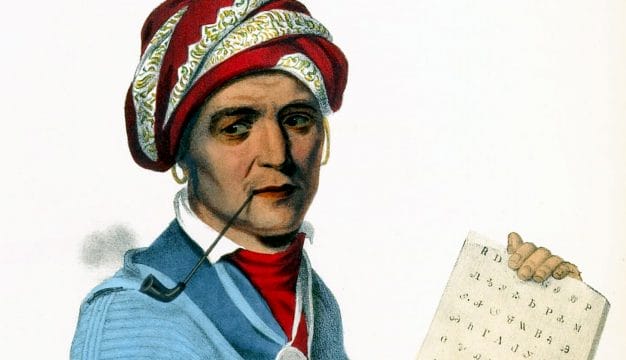Thomas Flournoy
During the War of 1812 and the Creek War of 1813-14, Brig. Gen. Thomas Flournoy (1775-1857) oversaw the Seventh U.S. Military District, which consisted of the Mississippi Territory (present-day Alabama and Mississippi), Louisiana, and Tennessee. From that position, he commanded Gen. Ferdinand Claiborne, who defeated Creek Indians at the Battle of the Holy Ground, and he also strengthened Fort Bowyer on Mobile Point but was generally considered a poor commander. He later briefly served as an Indian commissioner to the Creek Indians but resigned and was replaced by other commissioners who later negotiated the controversial 1821 Treaty of Indian Springs.
Flournoy was born in Henrico County, Virginia, on January 3, 1775, to Mathews Flournoy and Elizabeth Patsy Prior Smith Flournoy; he was the eighth of ten children. His large family encouraged his academic pursuits, so Flournoy attended the first law school established in the United States, Litchfield Law School, in Connecticut, and practiced law in Augusta, Georgia, before eventually joining the Georgia Militia and serving within the U.S. Army. In 1801, Thomas married Sophia Davis, with whom he had 14 children, although only ten of them survived to adulthood. Their marriage lasted for 28 years until Sophia's death in 1829. Five years later, Flournoy married Catherine Howell, and they had no children.
In 1812, Flournoy was commissioned a brigadier general and commanded troops along the Carolina-Georgia frontier. He was in charge of securing the coasts and defending U.S. citizens who resided in East Florida in the Patriot War, a minor conflict in the early 1810s instigated by Americans (the Patriots) seeking to claim control over Spanish Florida, with the blessing of Pres. James Madison.
This territory was considered open land to many families who wanted to move west, as territory in North Florida was no longer completely safe because of conflicts between Spain and the United States during the War of 1812. As these families left the contested land, they moved westward into the Mississippi Territory, seeking open land along the Alabama and Mississippi Rivers. Flournoy was tasked with maintaining peace there, and if that was not possible, to protect U.S. citizens against Native American raids.
In March 1813, Flournoy succeeded Gen. James Wilkinson as commander of the Seventh U.S. Military District, which consisted of Louisiana, the Mississippi Territory (present-day Alabama and Mississippi), and Tennessee. Wilkinson was then sent to command the Ninth U.S. Military District, which included New York, Vermont, and adjacent territory. As the conflict with the Red Stick faction of Creek Indians escalated after the July 1813 fight at Burnt Corn Creek and the August 1813 Creek attack on Fort Mims, Flournoy and the governors of Georgia, the Mississippi Territory, and Tennessee coordinated the American response. In Mobile, Mobile County, he met with and reluctantly facilitated Choctaw leader Pushmataha's service in the U.S. Army as a captain in the fight against the Red Sticks and authorized George Strother Gaines to raise troops among the Choctaws as well. In November 1813, Flournoy ordered Gen. Ferdinand Claiborne to raise troops in the Mobile area. Flournoy had Claiborne establish a supply depot some 80 miles north of St. Stephens, in preparation for war, that became a palisade known as Fort Claiborne. Claiborne would later encourage Flournoy to allow an attack against a large encampment of Red Stick Creeks at the Upper Creek settlement of Econochaca on the Alabama River, also known as the Holy Ground. There, Claiborne defeated a Creek force in December 1813 and burned the settlement.
Flournoy turned his attention to British threats against Mobile and ordered Col. John Bowyer to complete the construction of a fort at Mobile Point in Baldwin County, the entrance to Mobile Bay. The work had begun under Gen. James Wilkinson and the fort, located at the site of present-day Fort Morgan, was named Fort Bowyer. Flournoy later ordered the fort abandoned, but Gen. Andrew Jackson ordered it reoccupied in August 1814. The fort withstood several British land and naval attacks between September 1814 and February 1815 when it finally surrendered, though not until delaying the British in their quest to attack Mobile and New Orleans.
Flournoy came to be considered an ineffective commander and difficult to work with. He was criticized for the debacle at Fort Mims and the abandonment of Fort Bowyer. He resented that Thomas Pinckney, commander of the Sixth Military District that was headquartered in Charleston, South Carolina, had been given overall command of the forces fighting the Creeks in the Seventh District and was slow to provide them supplies and support. After he was passed over for promotion, he resigned from the Army in September 1814. He returned to Augusta, resuming his law practice, while Jackson was given command of the Seventh Military District.
In August 1820, Secretary of War John C. Calhoun appointed Flournoy and Andrew Pickens as Indian commissioners for the U.S. government and Flournoy returned to Alabama. Pickens had fought in the War if 1812 and had just served as governor of South Carolina and would settle in Alabama to plant cotton. Their task was to deal with the Cherokees and, most particularly, the Creeks in Georgia to gain title to their land in north Georgia. The assignment was complicated, however, by the presence of three Georgians who were selected by the governor as "commissioners." In essence, they represented Georgians who wanted compensation for material losses, including enslaved persons, at the hands of Creeks during frontier conflicts several decades prior and Georgians who were upset that the 1814 Treaty of Fort Jackson opened up much more land for white settlement in present-day Alabama than in Georgia and had pushed Creeks east into Georgia. Overall, they wanted the Creeks removed and to gain title to their land but had no federal authority to sign a treaty.
Flournoy became upset, as he believed Georgia's Indian commissioners were undermining his authority and complained to Calhoun. He, in turn, replied that Flournoy and Pickens needed to work with the Georgians because these treaties were more important to the government than one individual's reputation. By this time Pickens had already resigned, and Flournoy soon did as well, rather than endure this slight.
Ultimately, former North Carolina congressman Daniel M. Forney and Gen. David Meriwether concluded the Treaty of Indian Springs (1821), negotiated primarily with Creek leaders William McIntosh and Little Prince (Tustunnugee Hopoie). Under its terms, the Creek and other Muscogee tribes gave up roughly four million acres of land in Georgia (a long swath of land that stretched from around present-day Atlanta south to near present-day Albany between the Flint and Ocmulgee Rivers) in exchange for $200,000 disbursed in small installments over 14 years. In addition, Georgia agreed to pay its citizens' claims against the Creeks. The U.S. government hoped this treaty would prevent the smaller Muscogee tribes from unifying together and establishing a military alliance to fight against the white settlers swarming into Alabama, west Georgia, and Mississippi. After the treaty was signed, leaders of the Creek Nation agreed that they would never give up any more of their lands to the United States. But just four years later, a small faction of Creek leaders led by McIntosh signed the Second Treaty of Indian Springs, which forced the Creeks to give up all of their lands east of the Chattahoochee River to Georgia and Alabama. Though McIntosh was executed by Creek leaders for signing the treaty, which was later deemed fraudulent, the Second Treaty of Indian Springs forced the Creeks to move west of the Mississippi River.
In 1836, Flournoy fully retired from service. He died on July 24, 1857, at the age of 82, and was buried in Summerville Cemetery in Augusta, Georgia.
Further Reading
- Green, Michael D. The Politics of Indian Removal: Creek Government and Society in Crisis. Lincoln: University of Nebraska Press, 1985.
- Stephens, Kyle Massey. "To the Indian Removal Act, 1814-1830." PhD. Dissertation, University of Tennessee, Knoxville, 2013.
- Thomas Flournoy Papers (1799-1827). Manuscripts Division, William L. Clements Library, University of Michigan.
- Tucker, Spencer A. "Flournoy, Thomas." The Encyclopedia of the War of 1812. Santa Barbara, Calif.: ABC-CLIO, 1997.






